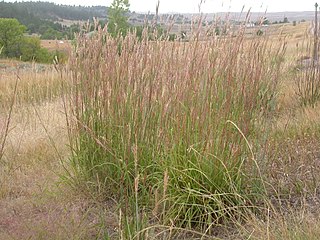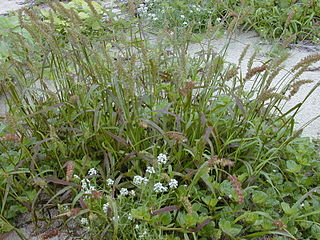
Begonia is a genus of perennial flowering plants in the family Begoniaceae. The genus contains more than 2,000 different plant species. The Begonias are native to moist subtropical and tropical climates. Some species are commonly grown indoors as ornamental houseplants in cooler climates. In cooler climates some species are cultivated outside in summertime for their bright colorful flowers, which have sepals but no petals.

Andropogon gerardi, commonly known as big bluestem, is a species of tall grass native to much of the Great Plains and grassland regions of central and eastern North America. It is also known as tall bluestem, bluejoint, and turkeyfoot.

Solanum aculeastrum is commonly known as soda apple, sodaapple nightshade, goat apple, poison apple, or more ambiguously as "bitter-apple". It is a poisonous nightshade species from Africa and not related to true apples. The term "soda apple" probably derives from "Sodom apple", modified due to the fruit's detergent properties.

Bouteloua curtipendula, commonly known as sideoats grama, is a perennial, short prairie grass that is native throughout the temperate and tropical Western Hemisphere, from Canada south to Argentina.

Deschampsia cespitosa, commonly known as tufted hairgrass or tussock grass, is a perennial tufted plant in the grass family Poaceae. Distribution of this species is widespread including the eastern and western coasts of North America, parts of South America, Eurasia and Australia.

Andropogon is a widespread genus of plants in the grass family, native to much of Asia, Africa, and the Americas, as well as Southern Europe and various oceanic islands.

Alsophila dregei, synonym Cyathea dregei, is a widespread species of tree fern in southern Africa.

Sisyrinchium montanum, the blue-eyed-grass, American blue-eyed-grass, or strict blue-eyed grass, is a grass-like species of plant from the genus Sisyrinchium, native to northern North America from Newfoundland west to easternmost Alaska, and south to Pennsylvania in the east, and to New Mexico in the Rocky Mountains. It has also been introduced to parts of France, likely during the First World War.

Digitaria sanguinalis is a species of grass known by several common names, including hairy crabgrass, hairy finger-grass, large crabgrass, crab finger grass, purple crabgrass. It is one of the better-known species of the genus Digitaria, and one that is known nearly worldwide as a common weed. It is used as animal fodder, and the seeds are edible and have been used as a grain in Germany and especially Poland, where it is sometimes cultivated. This has earned it the name Polish millet.

Cenchrus echinatus is a species of grass known by the common names southern sandbur, spiny sandbur, southern sandspur, and in Australia, Mossman River grass. It is native to North and South America. It is a clump-forming annual grass growing up to 80 cm (31 in) tall. The leaves occur with or without hairs and measure up to 12 mm (0.47 in) wide. The ligule is a fringe of hairs. The grass has barbed burrs of 4–10 mm (0.16–0.39 in) long.

Dactyloctenium aegyptium, or Egyptian crowfoot grass is a member of the family Poaceae native to Africa and Asia. The plant mostly grows in heavy soils at damp sites.

Chasmanthium latifolium, known as fish-on-a-fishing-pole, northern wood-oats, inland sea oats, northern sea oats, and river oats is a species of grass native to the central and eastern United States, Manitoba, and northeastern Mexico; it grows as far north as Pennsylvania and Michigan, where it is a threatened species. The species was previously classified as Uniola latifolia.

Trisetum is a genus of plants in the grass family, widespread in temperate, subarctic, and alpine habitats in much of the world. Oatgrass is a common name for plants in this genus.

Hygroryza (watergrass) is a monotyipic genus of Asian flowering plants in the grass family. The only known species is Hygroryza aristata, native to China, Bangladesh, Cambodia, India, Laos, Malaysia, Myanmar, Nepal, Pakistan, Sri Lanka, Thailand, Vietnam.

Tripidium ravennae, synonym Saccharum ravennae, with the common names ravennagrass and elephant grass, is a species of grass in the genus Tripidium. It is native to Southern Europe, Western Asia and South Asia. It is known in North America as an introduced species, where it is sometimes an invasive and troublesome noxious weed.

Bothriochloa ischaemum is a species of perennial grass in the family Poaceae, found throughout much of the world. It is commonly known as yellow bluestem. Two varieties are recognized, of which Bothriochloa ischaemum var. ischaemum is native to Europe, Asia, and Africa and naturalized elsewhere, and var. songarica is native to Asia and naturalized elsewhere. Var. songarica is an invasive weed in Texas, where it is known as "King Ranch bluestem"; it has displaced native grasses in large areas of central and south Texas.

Setaria verticillata is a species of grass known by the common names hooked bristlegrass, rough bristle-grass and bristly foxtail. It is native to Europe, but it is known on most continents as an introduced species and often a noxious weed. It is a hardy bunchgrass which grows in many types of urban, cultivated, and disturbed habitat. It is a weed of many types of agricultural crops, growing in vineyards and fields. Herbicide-resistant strains have been noted.

Begonia dregei, the maple leaf begonia or grape-leaf begonia, is a species of flowering plant in the genus Begonia native to the Eastern Cape and KwaZulu-Natal provinces of South Africa. It has gained the Royal Horticultural Society's Award of Garden Merit.

Paranomus dregei, the scented sceptre, is a flowering shrub belonging to the genus Paranomus. The plant is native to the Western Cape, South Africa.

Babiana dregei is a species of geophyte in the genus Babiana. It is endemic to the Northern Cape of South Africa, including Namaqualand.



















